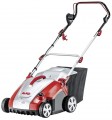Recommended area
The area of the site for which the device is designed. It cannot be argued that this parameter is critical when choosing a device, these are only manufacturer's recommendations and are very conditional. However, they are more than justified and, in general, show the available front of work based on the heating of the motor, the capacity of the tank or battery, and other factors that affect the duration of work.
Working width
The width of the strip processed by the aerator in one pass. The higher this indicator, the faster the device works, the fewer passes will have to be made to process a certain area. On the other hand,
a wide grip noticeably affects the dimensions of the entire structure and makes it difficult to work in hard-to-reach places, if not impossible. Therefore, when choosing a model in terms of working width, it is worth considering not only the overall dimensions of the site, but also its configuration and the presence of tight areas — sometimes it is preferable to sacrifice the performance of the aerator for the sake of its manoeuvrability and patency.
Working mechanism
The design of the working mechanism provided in the aerator, in other words, the number and types of working elements installed on the shaft. For verticutters (see "Type") such elements are blades, for scarifiers — spring teeth. For
combined models, in this case, the design of both working shafts is indicated, for example "14 knives / 20 spring teeth".
Motor power
The power of the aerator motor, expressed in watts. Today, the watt is the common unit of power and is used for both electric and petrol models (see "Engine type"). In general, the
more powerful the motor, the higher the performance of the unit, the greater the depth of processing and the working width (see above) can be provided in the aerator; however, the consumption of electricity / fuel also directly depends on the power. Therefore, when choosing an engine for their equipment, manufacturers proceed from a reasonable compromise between these properties, and in general, engine power allows you to evaluate the performance of the unit and its suitability for large volumes of work.

